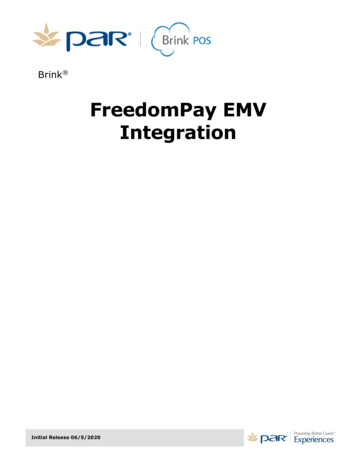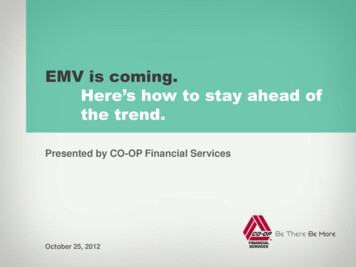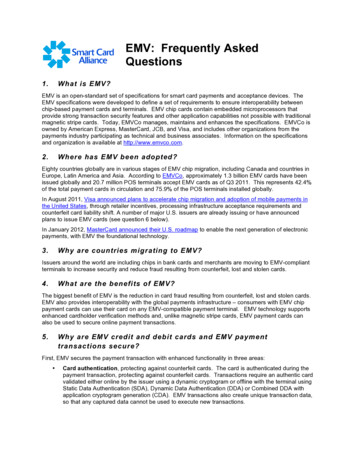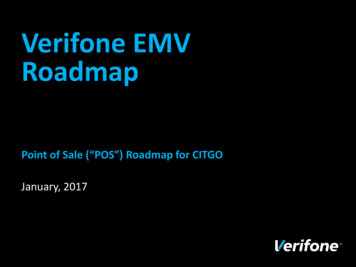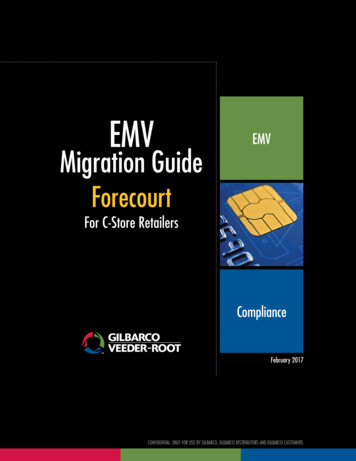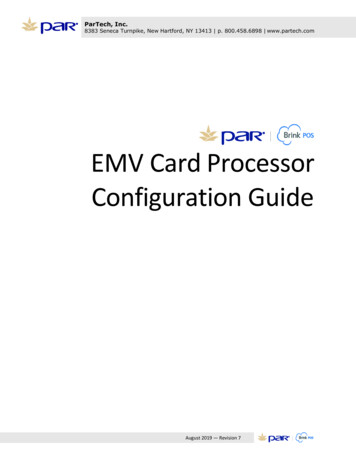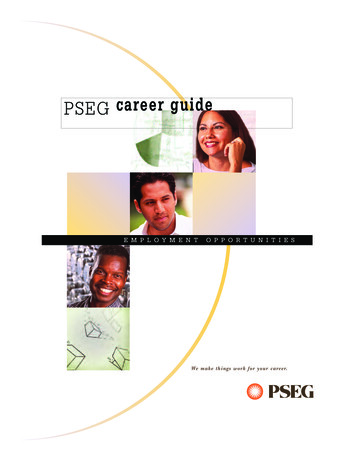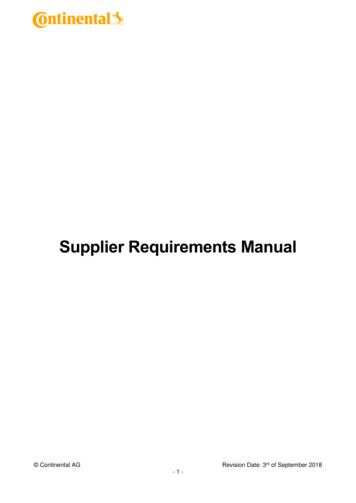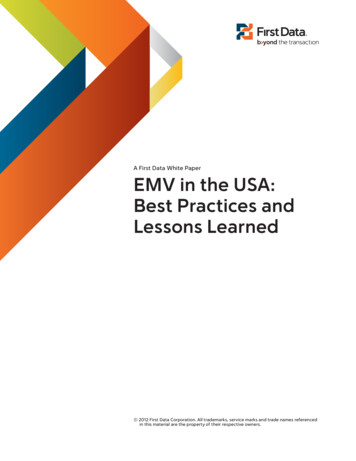
Transcription
A First Data White PaperEMV in the USA:Best Practices andLessons Learned 2012 First Data Corporation. All trademarks, service marks and trade names referencedin this material are the property of their respective owners.
EMV in the USA: Best Practices and Lessons LearnedA First Data White PaperIntroductionIndustry buzz about implementing an EMV-enabled1 payment infrastructure in the United Statesis becoming louder and more frequent. EMV provides the promise of reduced card payment fraudand enhanced global payments interoperability, and when combined with additional layers ofsecurity (like encryption and tokenization), it will undoubtedly benefit the entire payments valuechain. As the U.S. payments industry considers the various options of chip card adoption, issuersand merchants are beginning preparations for this new era of payment acceptance.In recent months, the major card networks (including Visa, MasterCard, Discover and American Express) have soughtto provide merchants, acquirers, issuers, and ATM operators with preliminary implementation guidelines by issuingEMV roadmaps. In addition, industry groups like the Secure ID Coalition, Smart Card Alliance and Merchant AdvisoryGroup have published their own roadmaps and recommendations. With some EMV readiness deadlines (for processors,specifically) coming as soon as April 2013, merchants, issuers, financial institutions and ATM operators should begindeveloping their strategies for full implementation.With so many players involved in the process, it is no surprise that there are varying opinions and some uncertainty aboutwhat EMV will look like as it rolls out in the U.S. market. This paper seeks to clarify some of this confusion by exploringvarious EMV implementation options and discussing some best practices that have emerged from successful EMV rolloutsthat have taken place around the world in recent years.What will EMV look like in the US?:Considerations and OptionsNow is the time to decide the direction that the U.S. implementation of EMV should take. The decisions around buildinga new payment infrastructure must focus on what will best serve the U.S. market as a whole, as well as consider theEMV experiences and lessons learned by other countries. As the last major economy to migrate to EMV, the U.S. is in afavorable position to adopt the best practices and avoid the mistakes that other countries experienced.Cardholder verificationAlthough EMV is often equated with “Chip and PIN,” they are not the same thing. Chip and PIN is just one possibleimplementation of the EMV technology. In fact, the technical specifications for EMV-enabled cards do not require a PIN, or asignature, or any other form of cardholder identity verification. Rather, the issuing bank specifies which cardholder verificationservices are required for a transaction with rules it places on the chip. Regardless, it is widely accepted that the combinationof card validation via the chip, and cardholder authentication with a PIN provides the greatest protection against commonconsumer-level attacks like fraudulent use of lost or stolen cards, counterfeit cards and skimming.1EMV-enabled payment cards have an embedded microprocessor chip that encrypts transaction data uniquely every time the card is used.The technology makes it much harder for thieves to skim useable data from the card and clone it for counterfeit use. The term “EMV” is derivedfrom the original developers of the technical standard: Europay, MasterCard and Visa. For more information see www.emvco.com.firstdata.com 2012 First Data Corporation. All rights reserved.2
EMV in the USA: Best Practices and Lessons LearnedA First Data White PaperProcessors will be able to support all cardholder verification methods, but Chip and PIN may be the preferred pathbecause it provides better security and falls in line with the standards outside the U.S. PIN provides greater fraud protection – PIN verification of the cardholder is more effective in protecting againstfraud losses compared to signature verification. Based on 2008 debit card fraud data collected by the FederalReserve Board of Governors, total fraud losses to all parties on signature based transactions per dollar volumewere .13 percent, or 13 basis points. PIN-based transactions experienced a significantly lower fraud loss rate of.035 percent, or 3.5 basis points, per dollar volume. In the event that a card is lost or stolen, PIN verification is moreeffective in combating fraud than signature verification.2 Chip and PIN is a de facto global standard – Most of the countries that have adopted the EMV technical standardfor chip-based payment cards have also adopted PIN-based cardholder verification. This includes two of the mostrecent EMV rollouts: in Australia, Visa mandated that all Visa card transactions use PIN as the verification method, andin Canada, PIN was designated industry-wide as the mandatory verification method for all EMV transactions. Chip and PIN is a proven solution – Other countries that have already implemented Chip and PIN have experiencedsuccessful results. For example, the United Kingdom is one of the earliest adopters of Chip and PIN technology basedon the EMV standard. Between 2005 and 2010, total card purchase volume grew 32 percent, while total card frauddecreased 17 percent. Lost and stolen card fraud is at its lowest level since the 1990s, and counterfeit card fraud is atits lowest level since 1998.3 U.S. must beware of Netherlands’ Chip and PIN adoption parallels – As countries in a particular geographic regionbegin implementing Chip and PIN standards, fraud rates in surrounding countries without EMV tend to experienceincreases in card fraud. As Europe was migrating to chip cards and PIN, the Netherlands had low card fraud rates andthus was slow to conform to its neighbors. Consequently, the fraud rate there skyrocketed from 1.5 percent in 2005 to5 percent in 2009—an increase of over 300 percent.4 The United States finds itself facing a similar situation now, withCanada and Mexico having recently adopted Chip and PIN. Failure to take swift EMV implementation actions will likelyresult in a substantial increase in card fraud.Transaction authorization optionsFor a chip-based transaction, it’s possible to authorize the payment using either an online or offline process. When onlineauthorization is used, transaction information is sent to the card issuer for approval. When an offline process is used, thetransaction information is transmitted from the terminal directly to the chip card itself for authorization by the chip. Transactionauthorization is determined by issuer-defined risk parameters stored in the chip, rather than direct approval by the issuer.A hybrid process is also possible, whereby cardholder verification is conducted via offline PIN, and the transaction itself isauthorized through online communication.Online and offline authorization options both have advantages. Online authorization allows for an additional layer of securityand fraud protection, since most fraud mitigation tools function online, in real-time. Online authorization also simplifies chipproduction, encryption key management and merchant infrastructure, and it saves cost and reduces overall complexity.The primary advantage of allowing offline authorization is that it is consistent with global standards, ensuring compatibility andinteroperability with international issuers’ payment devices. In addition, it allows for transaction authorization functionality evenin the absence of online connectivity (e.g., at a ticket kiosk or a farmer’s market) as in Europe where almost 7 percent of alltransactions rely on offline authorization.5Douglas King, Retail Payments Risk Forum working paper, “Chip-and-PIN: Success and Challenges in Reducing Fraud,” January 2012Financial Fraud Action UK, Working Together to Prevent Fraud Euromonitor Data4“Chip-and-PIN: Success and Challenges in Reducing Fraud”, King, Douglas, Retail Payments Risk Forum, January 20125“As U.S. Chip Adoption Advances, Visa Provides Guidance”, Ericksen, Stephanie, Perspectives on Digital Currency, January 13, 201223firstdata.com 2012 First Data Corporation. All rights reserved.3
EMV in the USA: Best Practices and Lessons LearnedA First Data White PaperOffline PIN considerations for issuersFor issuers that choose to verify cardholders using an offline PIN validation process, there are several items to considerpertaining to PIN management. The issuer must provide a process for customers to change their offline PINs (which couldinvolve using ATMs, IVR, merchants’ POS and/or in-branch services). In Europe, ATMs were updated to support cardholderPIN changes, and in Canada cardholders can also change their offline PINs at Canadian Post offices. If a card supports bothonline and offline PIN validation methods (as is the case for cards in most EMV countries), then separate online and offline PINscould exist. In this scenario, the issuer must either provide customer education on PIN management, or ensure that the PINs aresynchronized to avoid cardholder confusion.Card re-issuance strategies for issuersIssuing new chip-based credit and debit cards to customers will perhaps be among the most significant expenses andlogistical challenges faced by financial institutions as they migrate to EMV. As it was in Canada and Australia, the EMV rolloutin the United States is likely to occur in stages. A phased implementation is more manageable and it allows for adjustments asneeded along the way. As a result, issuers would be able implement a phased approach when it comes to card replacement.Rather than re-issue all cardholders’ cards simultaneously, they may be able to issue chip cards as legacy cards expire, oraccording to some other parameters.The deployment of trials and pilot rollout programs is an effective way to help issuers anticipate or avoid potential rolloutcomplications. In Canada, a one-year EMV pilot in Kitchener-Waterloo (participated in by the major card networks) has beenidentified as one of the reasons that the nationwide rollout went as smoothly as it did. The key finding from the associatedstudy was that a positive initial customer experience with EMV was a critical success factor for the adoption of the technology.Some other Canadian financial institutions conducted trials with small, internal test groups of around 1,500 friends and familyin order to work through education, customer support, messaging and FAQ tactics. The payments industry in Australia used atiered rollout when implementing EMV. Issuers produced chip cards first, and once 20 percent of the market was chip enabled,the requirements for EMV-enabled POS devices were issued. This proved to be a successful strategy for solving the “chickenand egg” conundrum that had delayed EMV adoption in that region.Instead of, or in conjunction with these types of pilots and trials, issuers may also wish to deploy a “portfolio strategy” whendetermining how best to conduct card replacement across their customer base. This would involve targeting specific segmentsof customers—for example, cardholders most likely to benefit from chip-based payments, such as international travelers whofrequently use their cards outside the U.S. There are several benefits to this approach: Cardholders may already be familiar with EMV and therefore require less education. Opportunity to become “top of wallet” for card use in the U.S., leading to increased retention and incremental revenue. Ability to gain experience in issuance process/level of support and education needed to issue EMV cardsThis strategy has been successful for the first U.S. EMV issuer, the United Nations Federal Credit Union (UNFCU)—whichtargeted international travelers for chip cards. One year after implementing this strategy, new account applications were up158 percent, revolving balances were up 20 percent and purchases were up 18 percent.6“Smart Card Alliance Annual Conference Day One – EMV and the United States” , SCA Press Release, May 4, 80%93-emv-and-the-united-states6firstdata.com 2012 First Data Corporation. All rights reserved.4
EMV in the USA: Best Practices and Lessons LearnedA First Data White PaperChip interface selection considerationsA dual-interface chip can support both contact and contactless transactions, allowing consumers to pay the way they prefer—by tapping, waving or inserting the payment card. Contact may be preferable for high-ticket purchases, where the volumeof transactions and the speed of individual transactions is not a factor. Contactless transactions may be preferable in highvolume, low-ticket situations where speed of transaction is important; for example, at a quick service restaurant. Whethercontact or contactless, the same chip-based security features are present.Many merchants are eager to benefit from newer payment options that chip-enabled payments can support. By supporting adual-interface implementation of EMV-enabled cards and terminals, banks and merchants would gain the following benefits: It meets Visa’s merchant requirement for the Technology Innovation Program (TIP) relief from PCI compliance reportingto Visa. To be accepted into TIP, eligible merchants are required to have at least 75 percent of transactions originate fromdual interface (contact and contactless) chip terminals and be capable of processing end-to-end chip transactions. Similarly, MasterCard plans to offer compliance testing and fee relief based on account-data volume. A merchant running75 percent of card transactions through an EMV terminal with both contact and contactless capabilities by 2013 wouldreceive 50 percent relief on PCI testing. By 2015, a merchant running 95 percent of its transactions through an EMVterminal would receive 100 percent relief. It will likely aid in the adoption of mobile payments due to new POS equipment enabled with NFC contactless. It helps to maximize merchants’ previous investments in POS devices by permitting the continued usage of compatibleNFC terminals. It ensures global interoperability (compared to a contactless-only implementation, which wouldn’t support manyinternational cards)Layered Approach to SecurityAs global experience demonstrates, the adoption of chip technologycan reduce fraud at the POS but can also drive higher card-not-present(CNP) fraud. In tandem with bringing in EMV at the POS, the issue of CNPfraud needs to be addressed strategically with additional security layerssuch as fraud protection solutions and increased verification methods.Much can be learned from the example of EMV rollout in the UnitedKingdom. According to the U.K. Payments Administration (formerlyAPACS), domestic card fraud in the U.K. dropped 32 percent in 2007(Chip and PIN became mandatory in 2006), while counterfeit cardfraud increased by 46 percent the same year. APACS claimed theincrease was “due to fraudsters copying U.K. cards and using thesestolen cards in countries which do not yet have Chip and PIN.”7 TheThe Importance of Layered DefensesWhile EMV helps mitigate fraud at the POS, it does notprotect cardholder data once the payment method andconsumer are validated. The cardholder and the carditself have now been validated through EMV but theactual card data is sent in the clear unless the merchanthas layered on an encryption and tokenization solutionto protect and remove sensitive card data from themerchant environment. A layered approach to fraudand security is the only way to truly be protected. Twoimportant layers include: Card data security – A strong encryption andtokenization solution can bolster the security ofthe entire payment transaction and reduce PCIcompliance efforts. Card fraud protection – Layer EMV with encryptionand tokenization plus online fraud and verification tools.situation improved somewhat by 2009, when APACS reported CNPfraud dropped by 19 percent and showed the first ever decreasesince 1999. It fell yet another 15 percent in 2010.8 APACS cites theincreasing use of sophisticated fraud screening detection tools byretailers and banks as well as the industry’s “Be Card Smart Online”campaign as the reason for the decrease.78Tracy Kitten, www.bankinfosecurity.com, “Is U.S. Ready for Chip & PIN?” June 1, 2010, www.bankinfosecurity.com/articles.php?art id 2593&pg 2Financial Fraud Action UK, “Fraud, the Facts 2011”firstdata.com 2012 First Data Corporation. All rights reserved.5
EMV in the USA: Best Practices and Lessons LearnedA First Data White PaperConsumer Education and Customer SupportWhile payment associations, FIs and merchants have been reading about and discussing EMV for quite some time, this topicis new to most American consumers (only 4 percent have even heard of EMV).9 They will need some amount of education–most likely in the form of a concerted industry marketing campaign—on why their payment cards are changing and how touse the new cards, in either a contact or contactless mode or both. Moreover, consumers are not accustomed to using a PINwith a credit transaction and would need to learn a new checkout procedure.We can look to Canada for consumer reactions to the new cards and processes. Cardholders who were accustomed tosigning credit receipts simply forgot to commit their new credit card PINs to memory. “The hardest thing for consumers andmerchants when it comes to payments is changing the process at the point of sale,” says Anne Koski, head of Business CreditCards for Royal Bank of Canada. “If consumers are not used to entering a PIN for credit card transactions, it is going to take awhile for them to get in the habit.”10 One potential remedy for avoiding the issue of “forgotten PINs” is allowing customers toset their own PIN rather than having a PIN assigned by the card issuer.Another issue is that consumers sometimes forgot to take their cards with them after inserting them into a POS device for atransaction. In Canada, the impact was so significant that terminal prompts were changed to remind cardholders to remove theircards, and merchant training was revised to include reminding customers to take their cards with them.11 Consumers also neededto be reminded by merchants to leave their cards in the card readers during the entire transaction for contact-based purchases.None of these challenges are showstoppers that cannot be overcome with consumer education campaigns and carefulplanning by institutions and merchants to be sensitive to consumers’ habits. Issuers should plan to use multiple touch pointsprior to card issuance to educate both merchants and consumers, including direct mail, websites, IVR, e-mail, videos, inbranch signage and FAQs. Financial institutions should also consider providing specialized EMV customer support for thenext 3 – 5 years, as their full portfolios are converted to chip payments (the United Nations Federal Credit Union mentionedabove implemented 24 x 7 customer service to assist with EMV-related questions as it began chip card rollout in the U.S.).Merchants must plan to conduct thorough training to help employees learn to think “chip”—cards, mobile phones, contact,and contactless. Employees must also be trained on any necessary changes to the transaction handling process, as wellas how to answer consumers questions about EMV. Furthermore, merchants should consider creating consumer-facingeducational materials, as well as “EMV Payments Accepted Here” messaging.A Blueprint for ImplementationConverting the entire U.S. national payments infrastructure from one system to another is a significant undertaking that maytake years. At this writing, it is up to the industry stakeholders to get together and decide which approaches provide themost cost-effective path to optimal payments security. The U.S. Federal government has so far taken a hands-off approach,although at some point there could be legislation to mandate standards
Ability to gain experience in issuance process/level of support and education needed to issue EMV cards This strategy has been successful for the first U.S. EMV issuer, the United Nations Federal Credit Union (UNFCU)—which targeted


